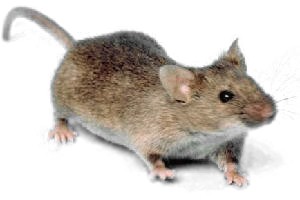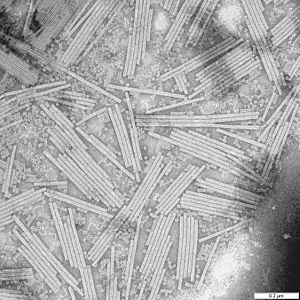History of model organisms facts for kids

The history of model organisms is about how scientists started using certain living things to learn about others. Think of a model organism as a "study buddy" that helps us understand how other, more complex organisms work. These special organisms are chosen because they are easy to study and have similar features or processes to other living things. Scientists try to make them very similar to each other (limiting their genetic differences) so that what they learn from one model organism can apply to many others.
The idea of using model organisms began in the mid-1800s. Famous scientists like Charles Darwin (who studied natural selection) and Gregor Mendel (who studied genetics and how traits are passed down) were among the first to explore this idea. As the 20th century began, model organisms started to appear in labs. In the early 1900s, Drosophila (fruit flies) became popular. Soon after, other models like tobacco mosaic virus, E. coli (a type of bacteria), and C57BL/6 (lab mice) joined them. These organisms have helped scientists make huge discoveries over the last century.
Contents
Early Ideas About Model Organisms
Some of the first steps towards using model organisms came from Gregor Johann Mendel. He felt that Charles Darwin's ideas didn't fully explain how new species formed. So, Mendel began his famous experiments with pea plants. He crossed and bred different pea plants to see how their traits were passed on. He discovered that he could isolate specific features, like pea color or shape.
Mendel made these discoveries in the 1860s, but his work wasn't widely known until 1900. Later, scientists realized his findings matched what they were learning about chromosomes inside the nucleus of cells. Mendel's work gave scientists a practical guide for breeding. This method was then used to select some of the first model organisms from other groups, such as Guinea pigs, Drosophila (fruit flies), mice, and viruses like the tobacco mosaic virus.
Modern Model Organisms
Fruit Flies: Drosophila
The fruit fly, Drosophila melanogaster, moved from nature into the laboratory in 1901. At Harvard University, Charles W. Woodworth suggested to William E. Castle that Drosophila could be useful for genetic studies. Castle and his students were the first to bring the flies into their labs for experiments.
Around 1906, Thomas Hunt Morgan started working with Drosophila. He became very famous for his research with these flies. Morgan was one of the first to see the potential in mapping the chromosomes of Drosophila melanogaster and all their known changes (mutations). He and other "Drosophilists" (scientists who study fruit flies) carefully observed and controlled mutations. They also cross-bred flies to create new traits. Thanks to many years of this work, these flies became very uniform and are still used in research today.

Tiny Organisms: Microbes
Insects weren't the only organisms entering labs for study. Bacteria were also introduced. In 1931, Ernst Ruska invented the electron microscope. This amazing invention allowed scientists to see things far too small for regular light microscopes, like viruses. Viruses had puzzled biologists for years, but now they could be studied closely.
In 1932, Wendell Stanley worked to be the first to completely isolate the Tobacco Mosaic Virus (TMV). This virus had been invisibly killing tobacco plants across England. Stanley succeeded by making the environment more acidic. He found that the virus was either a protein or very similar to one, which was a big help for future research.
These new, much smaller organisms like the Tobacco Mosaic Virus and E. coli (a common bacterium) became very important in molecular biology labs. Organisms like Drosophila were too large and complex for the simple experiments scientists wanted to do. Viruses and bacteria are much simpler, reproduce quickly, and are easy to grow in large numbers.
Today, viruses, including bacteriophages, are used a lot in genetics. They help researchers produce DNA inside bacteria. The Tobacco Mosaic Virus's unique DNA structure even helped scientists James Watson and Francis Crick develop their famous model of the helical (spiral) structure of DNA.
Bacteriophages are viruses that infect bacteria. Since 1939, they have been studied as model organisms to understand basic biological processes at a tiny, molecular level. Studies of bacteriophages helped scientists learn a lot about how DNA replication (copying DNA), DNA repair, and genetic recombination (mixing DNA) work. They also showed how viruses are built from proteins and nucleic acids. Experiments with bacteriophages even helped explain stop codons, which tell a cell when to stop making a protein.
Mice: Mammalian Models
While insects and viruses were important, scientists also needed to study mammals. Around the early 1900s, much biomedical research used animals, especially mammals, to understand life processes. At this time, animal welfare groups in America started to gain public support for animal rights.
During this period, a scientist named Clarence Cook Little began researching mouse cancers at Harvard Medical School. He started developing large colonies of mice with specific genetic traits. Under Dr. William Castle, Little helped expand animal breeding at Harvard's Bussey laboratory. They were able to create a big program in mammalian genetics.
Mice turned out to be almost perfect for studying mammalian genetics. People had been breeding mice for hundreds of years, which meant there were many different types. Also, people generally cared less about mice than about dogs or cats, making it easier for scientists to use them. Little used new ideas from plant and Drosophila genetics to create "pure genetic strains" of mice. He achieved his goal of a genetically pure strain of mice by 1911. He showed that inbreeding (breeding closely related animals) was a good way to reduce differences and keep unique genetic traits. These mice were also used a lot in cancer and tumor research.

Research with these mice continued through the 1920s. However, the Great Depression in the 1930s hit this field hard. Labs had to sell many of their mice just to stay open, which almost stopped the continuation of these special mouse strains. But eventually, the economy improved, and genetics labs resumed their research. Places like Jackson Laboratory were able to produce mice for research facilities all over the world. These mice were bred using Mendel's techniques, which Little had made standard practice around 1911. This meant that mice used in experiments were not only the same within one lab but also across different labs globally.
Mice remain very important today as molecular genetics and genomics have grown. The complete genetic map (genome sequence) of a reference mouse was finished in 2002. Studying and comparing the genomes of different organisms (called comparative genomics) has shown how important model organisms are, especially those with smaller, simpler genomes.
See also
 In Spanish: Historia de los organismos modelos para niños
In Spanish: Historia de los organismos modelos para niños
- History of animal testing
- History of research on Arabidopsis thaliana
- History of research on Caenorhabditis elegans


